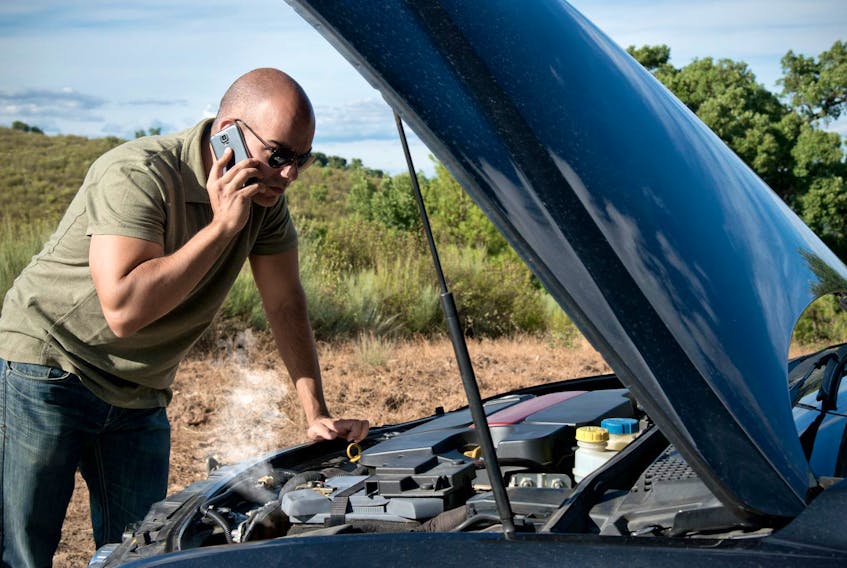Mechanical failure has become less likely in today’s vehicles, but as items wear, or if they are not properly maintained, problems can occur.
Engine failure
The most frightening prospect is total engine failure — it simply stops, and with it goes the power assist for both steering and brakes. There is a small spot of good news in this situation — the vehicle will slow rapidly all by itself. Use that to your advantage and concentrate on where you want to go and how you’ll get there. Both steering and braking will still be available. The steering will feel as though it won’t move, but it will, with a great deal of effort. The same with brakes. The amount of effort required will increase as speed drops which is why you should plan ahead.
If the engine stops, turn on the four-way flashers. You know where to find them in an emergency, don’t you? Look down the road; check all mirrors for surrounding vehicles and conditions. Once you’ve identified a likely spot to pull off, steer gradually toward it, avoiding braking until you have to.
If, at this stage, you have plenty of room and feel safe doing so, shift the vehicle into neutral (or depress the clutch) and try to re-start the engine. Don’t spend much time or expect success, but it’s worth a shot. Locate a spot to pull off. Steer gradually toward it and start applying brake pressure. Remember, there will be no boost or assist so you’ll have to apply plenty of pressure. As your speed drops, you can try using the parking brake as well.
But make sure your speed is way down and you know where the release is. The parking brake usually works on the rear wheels only and locks on. If you apply it in a panic and lock the rear brakes, you create a significant additional problem! With a foot brake, pull the release handle while applying pressure to slow the vehicle. With a hand brake, depress the button at the end and pull up on the handle slowly. If you have not used the emergency/parking brake frequently, it may not be properly adjusted and will likely apply pressure to only one rear wheel. So when you first apply it in an emergency, do so gently until you are sure it is working properly.
Brake failure
Almost as scary a proposition as the engine quitting is that of total brake failure. With the redundancy built into today’s systems this is a most unlikely occurrence. However, if you should experience that awful feeling, don’t panic. As with engine failure, above, get both hands on the wheel and your eyes working overtime. Check out your surroundings and find likely place to pull over. Put the transmission in a lower gear to promote engine braking and hit the four-way flashers. Try pumping the brake pedal rapidly to see if you can build up some residual pressure. Even if this is successful, continue to a safe spot, pull off the road and come to a stop. Do not continue until you have located and cured the problem or received assistance. Assuming pumping the brakes has no effect start using the emergency/parking brake as outlined above. As a very last resort, when speed is down below say 20 km/h, turn off the ignition. Be aware of two problems — do not move the key into the lock position as this will lock the steering wheel and prevent steering, and by shutting off the engine you will no longer have power steering, making it very stiff and hard to move.
Stuck accelerator
Apply the brakes. Even with the throttle wide open, the brakes will bring the vehicle to stop. Brakes win out over gas every time! As speed comes down to a near crawl, shift into neutral and shut off the ignition being aware of the attendant problems mentioned above. Once you’ve come to a safe stop, look and reach down to see if the pedal can be pulled back. The most common cause of this problem is floor mats jamming the pedal. Be wary when shifting into neutral and/or restarting the car. If the throttle is stuck open the engine can speed up to the point of very expensive self-destruction.
Fire
If you smell or see smoke or fire, pull to the side of the road, stop as quickly as possible and leave the vehicle being careful not to panic and either stop in an unsafe location or step out of your vehicle into traffic. Be very wary of opening the hood as this motion may supply a new source of oxygen for the fire and flash back at you.
Light failure
If your lights fail, slow as quickly and safely as possible while pulling to the side of the road. In most cases the four-way flashers will still work as they are on a separate circuit. Activate them immediately to warn others of your problem and use the extra light to pull off safely.
In all these instances the biggest cause of crash or injury results from panic. Try to simulate these instances in a big empty parking lot. Become familiar with the location of four-way flashers and the parking brake release, how to downshift. Turn off the ignition at very low speed to get a feel for the loss of steering and brake boost. A little practice will reduce the chance of panic.









